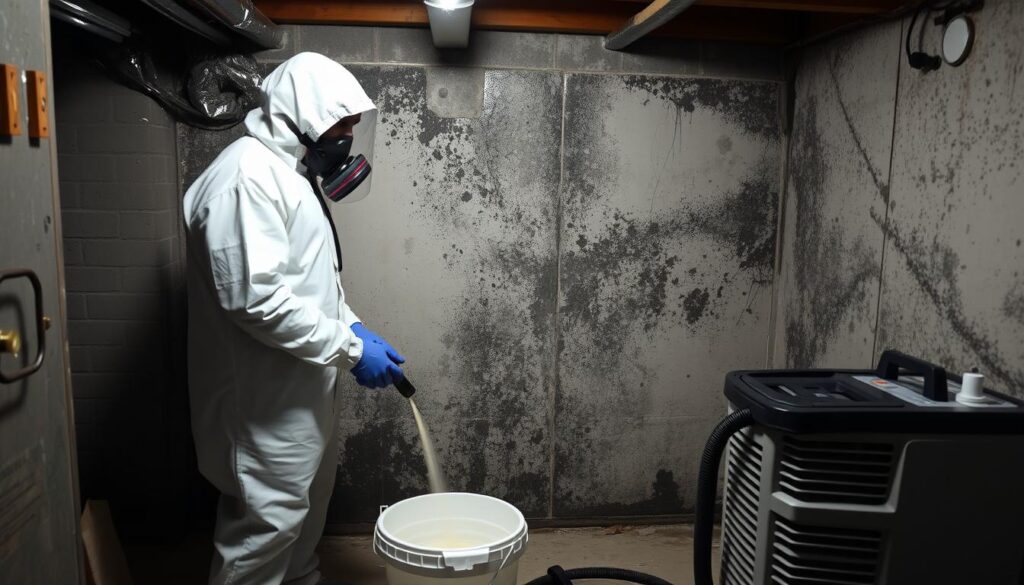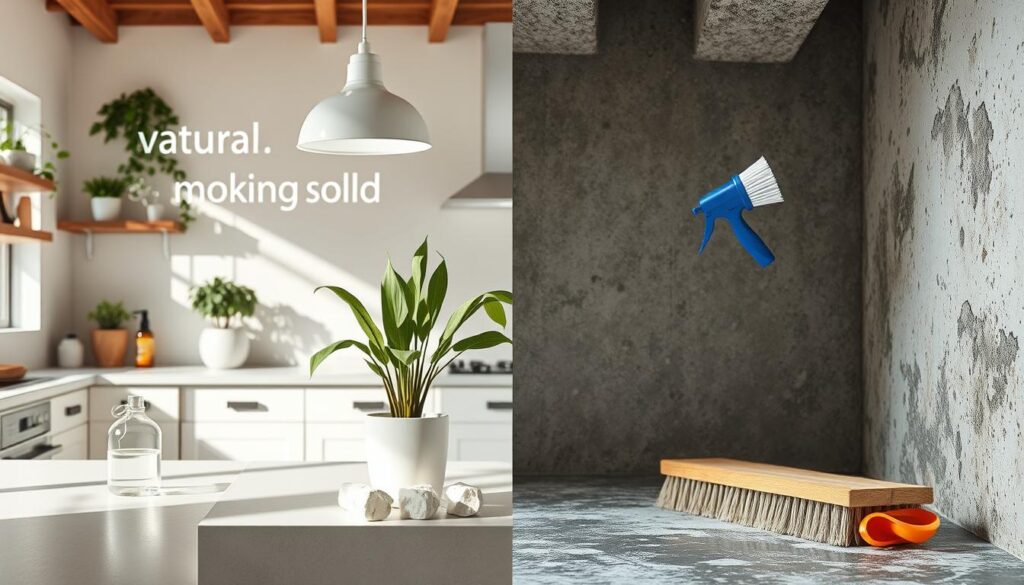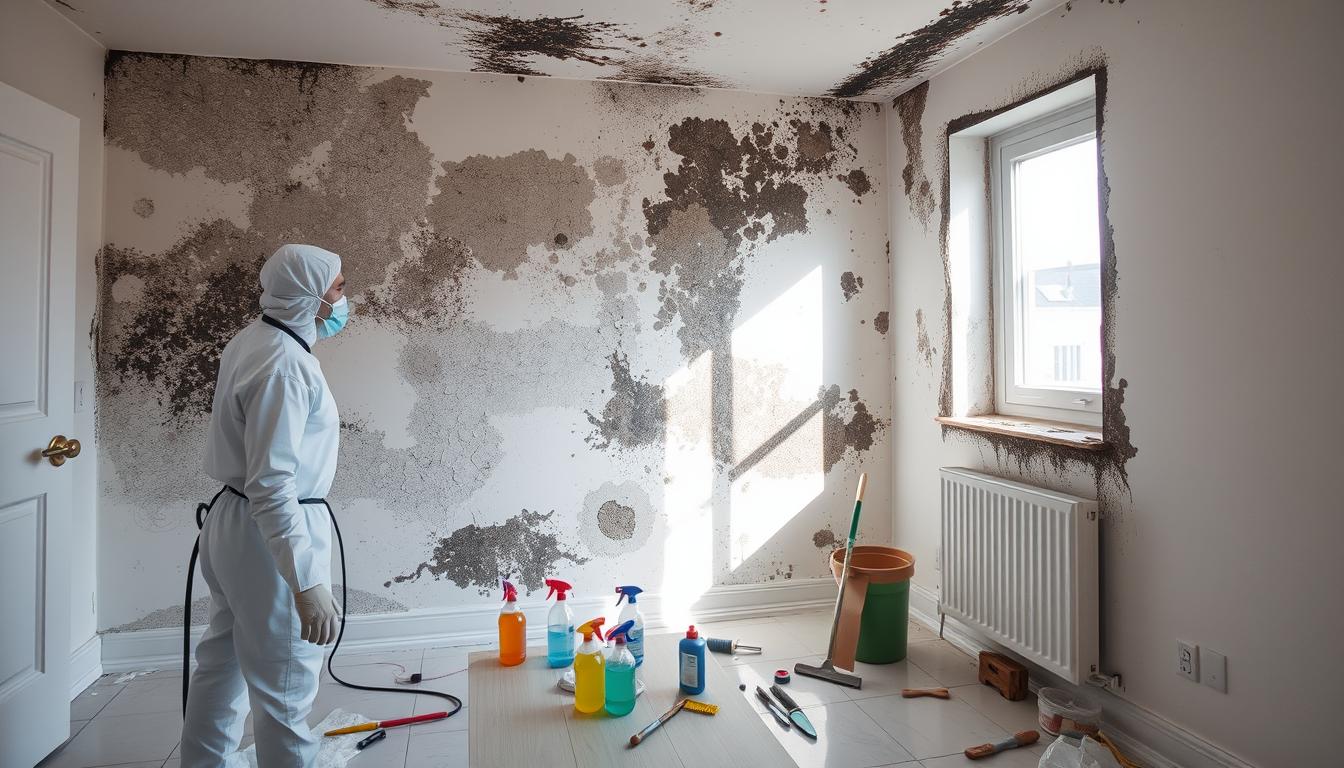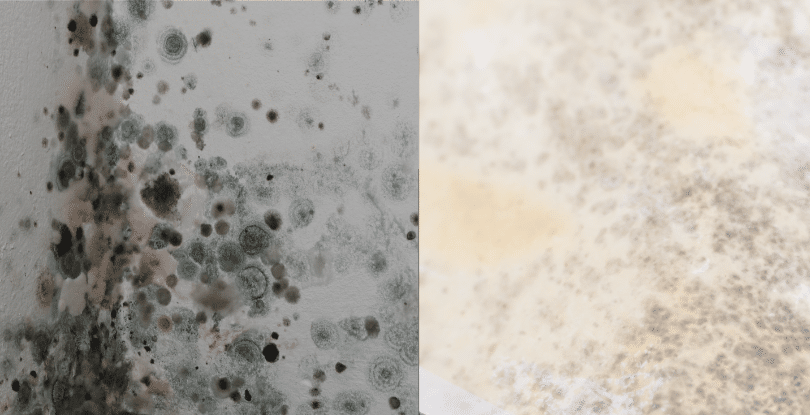Did you know black mold can start growing on wet surfaces in just 48 hours? This fact shows how fast mold can spread in your home. I’m here to help you understand how to find, remove, and stop toxic mold safely and well.
Black mold is a big problem that can harm your home and your family’s health. It loves moist places and can spread fast, affecting small areas. The best way to clean up mold is to act quickly and use the right methods.
In this guide, I’ll share tips on treating black mold, from DIY to professional services. You’ll learn about the gear you need, the best cleaning solutions, and how to stop mold from coming back. Let’s work together to make your home safe and healthy again.
Key Takeaways
- Black mold can grow within 48 hours on wet surfaces
- Prompt action is crucial for effective mold cleanup
- Proper protective gear is essential for safe mold removal
- Both DIY and professional methods are available for black mold treatment
- Controlling moisture is key to preventing future mold growth
- Regular cleaning and proper ventilation help maintain a mold-free home
Understanding Black Mold: What You Need to Know
Black mold is a common problem in homes that can harm our health. As a homeowner, I’ve learned it’s key to spot and fix this issue fast. Let’s explore what black mold is, where it grows, and why it’s important for our health.
What is black mold?
Black mold is a type of fungus that grows in damp places. It looks like brownish-black or greenish-black spots on walls, ceilings, and furniture. Not all dark molds are harmful, but they show there’s moisture in your home.
Common locations for black mold growth
Black mold likes humid, poorly ventilated areas. Some common places include:
- Bathrooms, especially around showers and tubs
- Basements and crawl spaces
- Kitchens, particularly under sinks
- Windows and windowsills
- Areas affected by water damage or leaks
Health risks associated with black mold exposure
Knowing the health risks of black mold is vital for a safe home. While not everyone reacts, some people may have:
| Mild Symptoms | Severe Symptoms |
|---|---|
| Stuffy nose | Asthma attacks |
| Coughing | Breathing difficulties |
| Itchy eyes | Allergic reactions |
| Skin rash | Respiratory issues |
If you think you have black mold, get a professional mold inspection. Early action can stop health problems and protect your home.
Identifying Black Mold in Your Home
Finding black mold in your home is key to a healthy living space. As a homeowner, I’ve learned early mold inspection stops serious health problems and expensive fixes. Let’s look at the main signs of black mold and where it hides.
Visual Signs of Black Mold
Black mold shows up as dark spots on surfaces. It can look like dark green or black splotches on walls, ceilings, or fabrics. Not all dark mold is toxic, but it’s wise to be cautious.
Odor Indicators
A strong, musty smell is a clear sign of black mold. If you notice an earthy or damp smell that won’t go away, it’s time for mold testing. This smell often means there’s mold hiding somewhere.
Hidden Mold: Where to Look
Black mold thrives in dark, damp spots. Here are the places I check during home inspections:
- Behind wallpaper or drywall
- Under carpets and rugs
- In attics and basements
- Around leaky pipes or windows
- Inside air conditioning units
| Location | Risk Level | Signs to Look For |
|---|---|---|
| Bathroom | High | Dark grout, peeling paint |
| Kitchen | Medium | Discoloration under sink |
| Basement | Very High | Musty odor, water stains |
| Attic | High | Dark spots on wood, damp insulation |
If you think you have black mold, getting help from experts is smart. They can do accurate mold testing and fix the problem. Your health and home are worth it.
The Importance of Prompt Black Mold Treatment
Acting fast when you see black mold at home is crucial. Quick treatment protects your health and property. Did you know mold over 10 square feet often needs a pro?
Black mold is not just ugly; it’s harmful. It can cause coughing, sneezing, and headaches right away. If ignored, it can lead to serious breathing problems and weaken your immune system.
This is a big risk for kids, the elderly, and those with health issues.
Here’s why acting quickly is important:
- It stops mold from spreading
- It keeps your home’s structure safe
- It ensures good air inside
- It avoids legal problems with property rules
- It keeps insurance claims valid
Waiting too long can cause more mold to spread. Don’t delay – fight black mold to keep your home safe and healthy.
Safety First: Preparing for Black Mold Removal
When dealing with toxic mold removal, safety is key. I’ve found that getting ready right can make a big difference. Here are the important steps to keep you safe while cleaning up mold.
Essential Protective Gear
Before starting, I put on the right gear. This includes:
- N-95 respirator mask
- Safety goggles
- Rubber gloves
- Full-body protective clothing
This gear keeps me safe from breathing in bad spores and touching mold.
Isolating the Affected Area
To stop mold spores from spreading, I seal off the area. I use heavy tarps and painter’s tape to make a barrier. This is very important for big areas, where you should get professional help.

Ventilation Considerations
Good airflow is crucial for cleaning up mold. I always turn off the HVAC system to stop spores from spreading. Instead, I use exhaust fans to blow air outside. This is important because mold can spread spores quickly, within 24 hours.
“Mold remediation should be left to professionals who have the equipment and expertise to handle mold safely and effectively.”
Remember, if the area is bigger than 10 square feet, it’s time to call the experts. Safety is the top priority in toxic mold removal. Getting ready right is the first step to a successful cleanup.
Black Mold Treatment: Step-by-Step Guide
Dealing with black mold can seem scary, but it’s doable with the right steps. I’ll guide you through a simple process to treat black mold safely and effectively.
Assessing Mold Growth
First, check how much mold you have. Use a moisture meter to find damp spots where mold likes to grow. If the mold covers more than 10 square feet, get professional help.
Removing Contaminated Materials
Get rid of items that can’t be cleaned, like carpets or drywall. For surfaces you can clean, get ready to scrub hard. Mold can grow fast, so act quickly.
Cleaning and Disinfecting
To treat black mold, mix baking soda, white vinegar, and water. Scrub well. Or, use hydrogen peroxide for a gentler option that doesn’t produce as many fumes.
Drying the Area
After cleaning, dry everything completely. Use dehumidifiers and fans to keep humidity below 60%. This step is key to stopping mold from coming back.
| Treatment Method | Effectiveness | Safety Considerations |
|---|---|---|
| Vinegar Solution | High (due to acetic acid) | Safe for most surfaces |
| Hydrogen Peroxide | Moderate | Less harsh, fewer fumes |
| Bleach | Low (for porous surfaces) | Can cause discoloration |
By following these steps, you can tackle black mold in your home. For big problems, it’s wise to get professional mold abatement services.
Natural vs. Chemical Solutions for Mold Remediation
Both natural and chemical solutions are useful for mold remediation. With over 15 years of experience, I’ve seen their effectiveness. It depends on the situation.
Natural solutions work well for small mold problems. White vinegar can kill 82% of mold species, including black mold. Baking soda absorbs moisture and is safe for homes and pets. For tough mold, 3% hydrogen peroxide is effective on various surfaces.

Chemical solutions, like Concrobium Mold Control and RMR-86, are strong for big mold problems. These products, once only for pros, are now available in stores and online. They’re great for large infestations or hard-to-remove mold stains.
| Solution | Effectiveness | Safety | Availability |
|---|---|---|---|
| White Vinegar | 82% of mold species | Very safe | Widely available |
| Baking Soda | Absorbs moisture | Safe for pets | Common household item |
| Hydrogen Peroxide (3%) | Highly effective | Safe on surfaces | Drugstores |
| RMR-86 | Removes tough stains | Strong fumes | Hardware stores, online |
Effective mold remediation goes beyond just killing mold. It’s also about fixing moisture issues to stop it from coming back. Whether you pick natural or chemical methods, always put safety first and follow the instructions.
Professional Mold Remediation: When to Call the Experts
Dealing with mold can be challenging. Small spots might be okay, but big infestations need experts. Let’s look at when to get help and what happens during the process.
Signs that DIY methods aren’t enough
If mold covers more than 10 square feet, it’s time for professionals. DIY on big areas can spread spores and make things worse. Mold in walls or air ducts also needs expert care.
Benefits of professional mold removal services
Professional mold removal has many benefits:
- Expertise: Specialists with 10+ years of experience handle complex cases effectively
- Equipment: They use specialized tools like HEPA air scrubbers and commercial dehumidifiers
- Safety: Pros use proper protective gear and containment methods
- Thoroughness: They identify and address moisture sources to prevent future growth
What to expect during professional remediation
Experts usually:
- Conduct a thorough inspection
- Contain the affected area with plastic sheeting
- Remove contaminated materials
- Clean surfaces with antimicrobial chemicals
- Dry the area completely
Most projects take 1 to 3 days. Costs can go over $1000. But, professional services keep your home safe and your family healthy.
| Aspect | DIY Removal | Professional Remediation |
|---|---|---|
| Suitable for | Areas under 10 sq ft | Large areas, hidden mold |
| Equipment | Basic cleaning supplies | Specialized HEPA equipment |
| Time | Varies | 1-3 days typically |
| Cost | Low | $1000+ |
| Effectiveness | Limited | Comprehensive |
Preventing Future Mold Growth: Moisture Control Strategies
Keeping mold away is all about controlling moisture. After dealing with black mold, I focus on preventing it from coming back. It’s important to keep indoor humidity below 50% to stop mold from growing.
Fixing leaks quickly is a top strategy for me. Even small drips can cause big problems if not fixed. I also make sure to use exhaust fans in places like bathrooms and kitchens. This helps remove extra moisture.
In damp areas of my home, I use dehumidifiers. These devices are great for basements or other moist spaces. Outside, I keep my gutters clean and working well to keep water away from my home’s foundation.
- Fix leaks immediately
- Use exhaust fans in bathrooms and kitchens
- Install dehumidifiers in damp areas
- Maintain clean and functional gutters
- Keep indoor humidity below 50%
I also use mold-resistant products in high-risk areas. For example, I choose paints with mold inhibitors when repainting. In my bathroom, I regularly use a mold-killing cleaner to prevent buildup.
By following these mold prevention tips, I’ve greatly reduced the risk of mold in my home. Remember, keeping moisture under control is essential for a mold-free home.
Restoring Your Home After Black Mold Treatment
After getting rid of mold, I work on making my home look new again. This means fixing damaged spots, making the air cleaner, and stopping mold from coming back.
Repairing Damaged Surfaces
I begin by fixing any mold-damaged areas. This includes replacing drywall, using special paint, and fixing wood. It’s important to dry everything out first.
Improving Air Quality
To make the air better, I use HEPA air purifiers and change HVAC filters often. Good air flow is key, especially in wet places like bathrooms and kitchens. Keeping humidity between 30-50% helps stop mold.
Monitoring for Recurrence
It’s important to watch for mold coming back. I check for moisture or mold signs often. If I find any, I fix it right away to stop bigger problems.
| Area | Action | Frequency |
|---|---|---|
| Bathrooms | Ventilate after use | Daily |
| Kitchen | Check for leaks | Weekly |
| Whole house | Monitor humidity | Ongoing |
By taking these steps, I keep my home mold-free and healthy. Remember, regular care and quick action are crucial for preventing mold.
Long-Term Health Considerations Post-Mold Exposure
After dealing with toxic mold removal, I’ve learned that the journey to full health recovery isn’t always straightforward. Black mold health risks can linger even after the visible threat is gone. It’s crucial to stay vigilant and monitor your health closely in the weeks and months following exposure.
I’ve found that some people may experience ongoing respiratory issues or allergic reactions. These symptoms can be subtle, like occasional wheezing or persistent fatigue. If you’re concerned about long-term effects, it’s wise to consult with a healthcare professional about potential mold-related health. They can provide guidance on managing symptoms and recommend appropriate treatments if needed.
To minimize future black mold health risks, I always stress the importance of maintaining a clean, dry indoor environment. This means keeping humidity levels in check, fixing leaks promptly, and ensuring proper ventilation throughout your home. Remember, prevention is key when it comes to toxic mold removal and protecting your long-term health.
FAQ
What is black mold?
Black mold refers to several dark-colored fungi. They often look like brownish-black or greenish-black dots. These fungi grow well in moist places and can stick to many surfaces, especially porous ones.
What are the common locations for black mold growth?
Black mold usually grows in bathrooms, basements, and places with water damage. It also thrives in areas with high moisture levels.
What are the health risks associated with black mold exposure?
Being exposed to black mold can lead to allergic reactions and asthma attacks. It can also cause respiratory problems, especially for people with weak immune systems.
How can I identify black mold in my home?
Look for black or dark gray spots on surfaces. These spots often come with a musty smell. Hidden mold can be found behind drywall, wallpaper, or in other hidden spots.
Why is prompt black mold treatment important?
Treating black mold quickly is key to protect your home and health. If not treated, it can spread fast, causing damage and health problems.
What safety precautions should I take during black mold removal?
Wear protective gear like an N-95 respirator, safety goggles, rubber gloves, and skin-covering clothes. Keep the affected area isolated and ensure good ventilation.
How do I remove black mold from surfaces?
Remove any materials that can’t be cleaned. For surfaces that can be cleaned, mix baking soda, white vinegar, and water, or use a commercial mold remover. Scrub well and dry completely.
When should I consider professional mold remediation services?
Call professionals for mold removal if the infestation is big (over 10 square feet), hidden, or DIY methods don’t work.
How can I prevent future mold growth in my home?
To stop mold from coming back, control moisture, fix leaks, and improve air flow. Use dehumidifiers and keep humidity levels below 50%. Regular checks and upkeep are essential.
What steps should I take to restore my home after black mold treatment?
Fix any damaged surfaces and paint treated areas with mold-resistant paint. Use HEPA air purifiers to improve air quality. Keep an eye out for mold coming back.
Are there long-term health considerations after mold exposure?
Some people may still have health issues even after mold is removed. Watch for ongoing respiratory problems, allergic reactions, or other mold-related symptoms. If you’re concerned, talk to a doctor.




